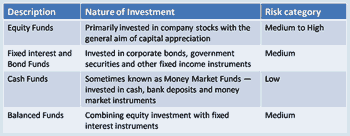
A Unit Linked Insurance Policy or ULIP is a combination of life insurance and a market linked investment product. Therefore it provides you life cover as well as capital appreciation. The allocated (invested) portions of the premiums after deducting all the charges and premium for risk cover policies chosen by all investors are pooled together to form a fund and units are allocated from this fund as per your invested amount.
Guaranteed returns?
ULIPs were originally meant to channelise savings to create wealth in the long term. But many ULIPs are today being sold as a tax saving and guaranteed return product with promises like this "You invest Rs X and we will double the money in 5 years". It is often accompanied by attractive graphs and charts showing you how your money will grow. As an investor, you must understand that the charts are usually based on some assumptions. Similarly the returns during good times are highlighted but same is not shown to you for the periods when the fund didn't perform well.
IRDA makes it mandatory for every insurer to provide an illustration to accompany every ULIP sold. This illustration should project returns assuming 6 and 10 per cent annualised returns and take the signature of the policy holder on the same. Investors should be aware that the returns may or may not materialise. Moreover the actual returns will be net of charges and expenses.
As a thumb rule, the net return is between 5.5 to 6 per cent if the plan annualised return is 10 per cent over a period of 10 years. The net return is higher for a period beyond 10 years.
Illustration: Rediff Archives
Investmentyogi.com is a one-stop personal finance website which helps in managing finances, investments and taxes through services like financial planning, online tax filing, budgeting and 'Ask the Expert'.

Most insurers offer a wide range of funds to suit one's investment objectives, risk profile and time horizons. Different funds have different risk profiles. The potential for returns also varies from fund to fund.
The following [table] are some of the common types of funds available along with an indication of their risk characteristics.
Charges and fees*
ULIPs offered by different insurers have varying charge structures. Broadly, the different types of fees and charges are given below. As per IRDA (Insurance Regulatory Development Authority) norms, insurers have the right to revise fees and charges over a period of time.
Premium Allocation Charge
This is a percentage of the premium appropriated towards charges before allocating the units under the policy. This charge normally includes initial and renewal expenses apart from commission expenses.
Mortality Charges
These are charges to provide for the cost of insurance coverage under the plan. Mortality charges depend on number of factors such as age, amount of coverage, state of health, etc.
Fund Management Fees
These are fees levied for management of the fund(s) and are deducted before arriving at the Net Asset Value (NAV).
Policy/ Administration Charges
These are the fees for administration of the plan and levied by cancellation of units. This could be flat throughout the policy term or vary at a pre-determined rate.
Surrender Charges
A surrender charge may be deducted for premature partial or full encashment of units wherever applicable, as mentioned in the policy conditions.
Fund Switching Charge
Generally a limited number of fund switches may be allowed each year without charge, with subsequent switches, subject to a charge.
Service Tax Deductions
Before allotment of the units the applicable service tax is deducted from the risk portion of the premium.
It should be noted that the portion of the premium after deducting for all charges and premium for risk cover is utilised for purchasing units. However the quantum of premium used to purchase units varies from product to product.
*Source: IRDA
Investmentyogi.com is a one-stop personal finance website which helps in managing finances, investments and taxes through services like financial planning, online tax filing, budgeting and 'Ask the Expert'.

The charges and various other expenses are front loaded ie high in initial years. Over a long period of time they even out. Thus ULIPs make sense only if you plan to stay invested for 10-15 years or more. Marketing agents often try to sell ULIPs as three-year products for tax saving purpose and suggest you withdraw the proceeds at the end of three years. That is a sure shot way to lose money as you will end up paying all the charges but not reap the benefits of appreciation.
Free Look period
As per IRDA, the policyholder can seek refund of premiums if he disagrees with the terms and conditions of the policy, within 15 days of receipt of the policy document (Free Look period). The policyholder shall be refunded the fund value including charges levied through cancellation of units subject to deduction of expenses towards medical examination, stamp duty and proportionate risk premium for the period of cover.
Switching facility
"SWITCH" option provides for shifting the investments in a policy from one fund to another provided the feature is available in the product. Many policies give you multiple fund options and you can decide your allocation according to the market conditions. Switch should be used intelligently to protect your investments during turbulent times by making a switch to safer debt funds and during boom time you should switch to more of equity funds. You need to be aware of the fund options provided by the policy before you sign up.
Illustration: Uttam Ghosh
Investmentyogi.com is a one-stop personal finance website which helps in managing finances, investments and taxes through services like financial planning, online tax filing, budgeting and 'Ask the Expert'.

If all the premiums have not been paid for at least three years continuously, the insurance cover ceases to exist. You will be paid the surrender value in that case. The tax benefits cease to exist when an individual wants to get out of a ULIP before three years ie any contribution made towards the policy during the financial year is not eligible for a deduction under section 80C. On top of this, deductions that have already been taken in the previous years would be added back as the income of the individual in that particular year of policy termination.
Under the 'premium holiday' feature, most ULIPs continue running if premium payment is stopped after the first three years, with the charges being deducted from the fund value through the term. While you may stop premium payments after three years and keep a ULIP going, the contract between you and the insurer will be terminated when, after deduction of charges, the fund value becomes equal to or less than one year's premium. So, you need to keep an eye on the fund value if you exercise the option of stopping premiums after three years.
So to sum up:
But,
Illustration: Uttam Ghosh
Investmentyogi.com is a one-stop personal finance website which helps in managing finances, investments and taxes through services like financial planning, online tax filing, budgeting and 'Ask the Expert'.